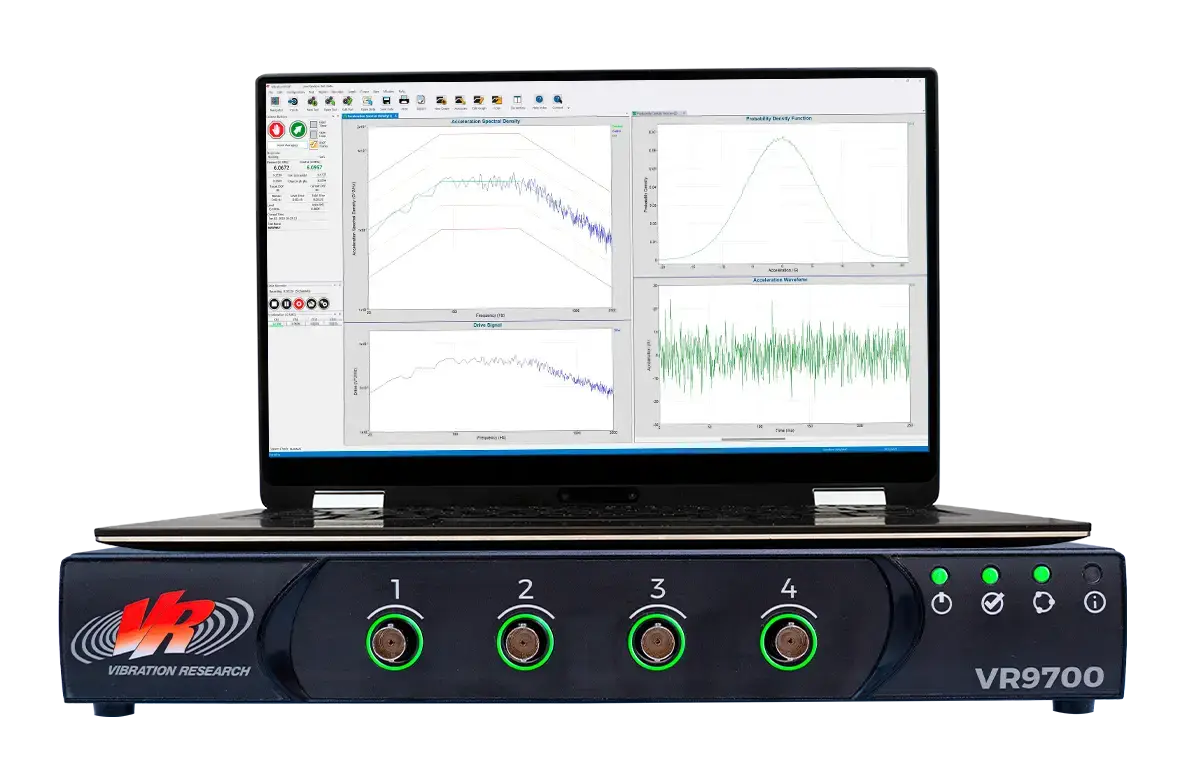LabroTek provides cutting-edge vibration controllers that deliver exceptional precision and reliability for all your vibration testing needs. Our comprehensive range of controllers supports applications across research and development, manufacturing processes, quality control, and product validation operations.

Our vibration control systems provide reliable performance for various testing requirements:
For advanced vibration analysis and measurement:
Our specialists help you identify the ideal equipment for your specific applications and requirements
Professional setup and comprehensive operator training to ensure optimal performance from day one
Dedicated assistance throughout your equipment's service life, including troubleshooting and updates
Regular service programs to maintain accuracy, compliance, and maximize operational uptime
Our vibration controllers incorporate cutting-edge technology to deliver exceptional testing performance:
Advanced DSP architecture enabling fast loop times and precise control for even the most demanding test profiles
Scalable systems supporting multiple input channels for comprehensive monitoring and control of complex test setups
Sophisticated algorithms that protect valuable test specimens and shaker systems from potential damage
User-friendly software with logical workflow design for efficient test setup, execution, and analysis
Equipment designed to meet ISO, IEC, MIL-STD, ASTM, and other global vibration testing standards
Vibration controllers are essential across numerous sectors:
Testing avionics, satellite components, and military equipment for vibration resistance in extreme environments
Validating vehicle components, electronic systems, and assemblies for durability under road conditions
Evaluating circuit boards, connectors, and portable devices for vibration resilience during transport and use
Assessing the reliability of life-critical equipment under shipping and operational vibration conditions
Testing durability and performance of products exposed to vibration during shipping and normal use
Validating components for turbines, generators, and power distribution systems under operational vibration
Testing railway components, shipping containers, and packaging systems for vibration resilience during transit
Sine testing applies a single frequency vibration at any given moment, sweeping through a frequency range to identify resonances and test at specific frequencies. Random testing applies a spectrum of frequencies simultaneously, providing a more realistic simulation of many real-world environments. Each method serves different testing objectives, and modern controllers can perform both types of tests with high precision.
The required number of channels depends on your test complexity, specimen size, and control strategy. Single-channel control is sufficient for many applications, while multi-channel control becomes necessary for large test items, multi-axis testing, or when implementing control strategies like averaging or notching. LabroTek can help assess your specific requirements and recommend an appropriate configuration.
Modern vibration controllers typically support a wide range of test types including sine, random, shock, mixed-mode, sine-on-random, random-on-random, classical shock, SRS shock, road simulation, and time waveform replication. Advanced controllers can also perform specialized tests such as fatigue damage spectrum analysis, kurtosis control, and multi-axis testing.
Controllers employ multiple layers of protection including drive limits, abort tolerances, alarm limits, and pre-test checks. These features monitor acceleration levels, displacement, voltage outputs, and test parameters in real-time, automatically adjusting or shutting down the test if safety thresholds are exceeded, preventing damage to both the test item and expensive shaker equipment.
Yes, modern controllers excel at replicating real-world conditions through time waveform replication (TWR) and field data replication (FDR) capabilities. These functions allow engineers to record actual field vibrations and reproduce them in the laboratory with high fidelity, creating more relevant tests than standardized profiles alone.
Loop time is the interval at which the controller updates its control signal to the shaker. Shorter loop times enable more precise control, especially at higher frequencies and during transient events like shocks. Advanced controllers achieve loop times of just a few milliseconds, providing the responsiveness needed for accurate reproduction of complex vibration profiles.
Integration typically involves positioning the shaker to interface with the chamber, using special feedthrough ports for cables, and coordinating control systems. Advanced vibration controllers can communicate with environmental chambers via digital interfaces to synchronize vibration profiles with temperature and humidity changes. LabroTek provides complete integrated solutions and expert guidance for combined environmental and vibration testing.
Contemporary controllers include comprehensive analysis tools such as FFT analysis, transfer function calculation, coherence measurement, histograms, probability density functions, fatigue damage spectrum analysis, SRS calculations, and statistical tools. Many systems also offer customizable reporting features and data export capabilities for further analysis in specialized software.
Yes, most modern vibration controllers support remote operation through network connections, allowing engineers to monitor and control tests from different locations. This capability is particularly valuable for long-duration tests, hazardous testing environments, or when expertise is needed from remote team members. Advanced systems include security features to ensure only authorized personnel can control testing operations.
Maintenance typically includes regular calibration of input channels and output signals, inspection of cables and connections, software updates, and occasional hardware diagnostics. LabroTek provides comprehensive maintenance services and preventative maintenance plans to ensure optimal controller performance and testing accuracy throughout the system's lifespan.